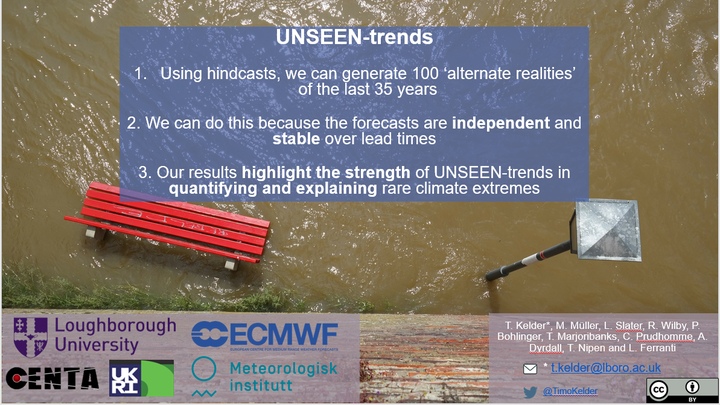UNSEEN trends: Towards detection of changes in 100-year precipitation events over the last 35 years

Abstract
Constraining the non-stationarity of climate extremes is a topical area of research that is complicated by the brevity and sparsity of observational records. For regions with available data, analyses typically focus on detecting century-long changes in the annual maxima. However, these are not necessarily impact-relevant events and hence, a potentially more pressing research challenge is the detection of changes in the 1-in-100-year event. Furthermore, recent decades have seen abrupt temperature increases and therefore detecting decadal, rather than centurial, trends may be more important. An alternative approach to the traditional analysis based on observations is to pool ensemble members from seasonal prediction systems into an UNprecedented Simulated Extreme ENsemble (UNSEEN). This method creates numerous alternative pathways of reality, thus increasing the sample size. Previous studies have shown promising results that improve design value estimates by this method. Here, we use the hindcast of the ECMWF seasonal prediction system SEAS5 and pool together four lead times and 25 ensemble members, resulting in an ensemble of 100. We assess the robustness of this method in terms of the ensemble member independence, model stability and fidelity and then use the UNSEEN ensemble to detect non-stationarities in 100-year precipitation estimates over the period 1981-2016. We justify the pooling of ensemble members and lead times through a case study of autumn 3-day extreme precipitation events across Norway and Svalbard, which shows that the ensemble members are independent and that the model is stable over lead times. Despite previously reported model biases in the sea-ice extent and the sea-surface temperature in SEAS5, validation measures indicate that the model reliably reproduces ‘visible extremes’, i.e. the seasonal maxima. Using extreme value statistics, we then compare estimated return values from observations with the UNSEEN ensemble. Results indicate that the UNSEEN approach provides significantly different extreme values for return periods above 35 years. Additionally, while it is problematic to detect trends in the 100-year values from observations, the UNSEEN approach finds a significant positive trend over Svalbard. Validating UNSEEN events and trends is a complex task, but our approach reproduces ‘visible’ extremes well, building confidence in the modeled extremes. Both Norway and Svalbard have experienced severe floods from extreme precipitation events and our UNSEEN-trends approach is the first to provide an indication of the changes in these rare events. Further application of this approach can 1) help estimating design values, especially relevant for data-scarce regions 2) detect trends in rare climate extremes, including other variables than precipitation and 3) improve our physical understanding of the non-stationarity of climate extremes, through the possible attribution of detected trends.
No details.